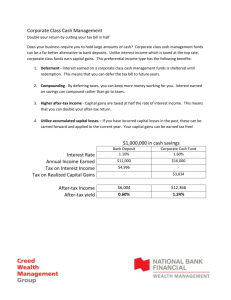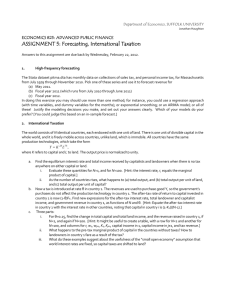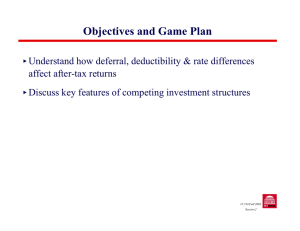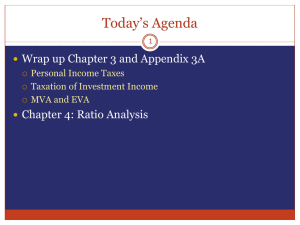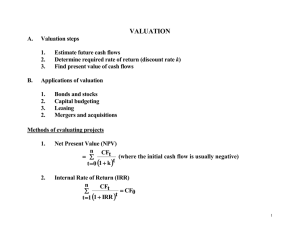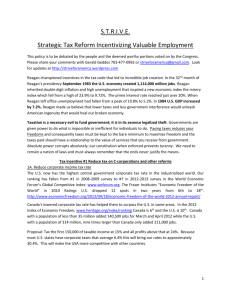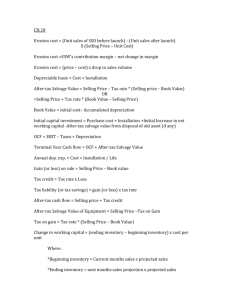Document 13620761
advertisement
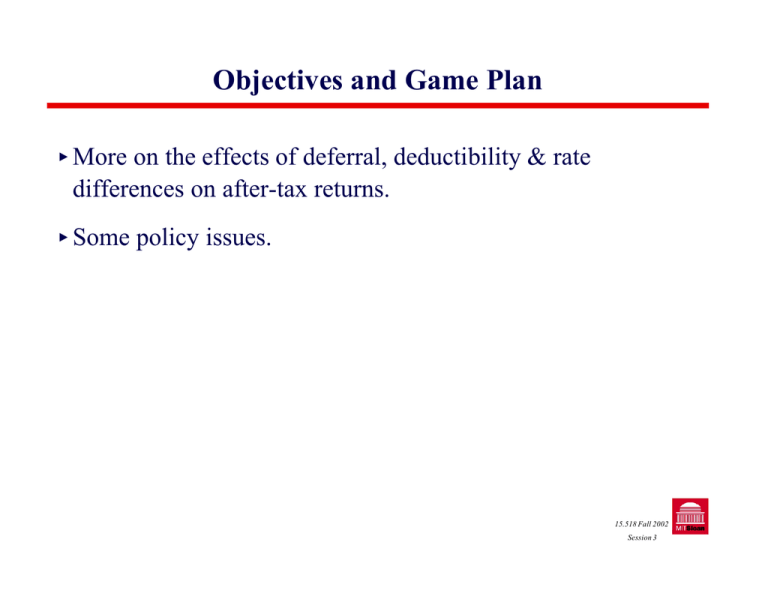
Objectives and Game Plan � More on the effects of deferral, deductibility & rate differences on after-tax returns. � Some policy issues. 15.518 Fall 2002 Session 3 Tax Planning versus Investment Expertise Investors traditionally paid little attention to the effect of taxes on mutual fund returns. This began to change in the early 1990s when Charles Schwab & Co. introduced a series of "tax-efficient" funds and began publicizing a study quantifying the effect that taxes have on mutual fund returns. Since then, more investors have begun paying attention to a fund's taxable distributions. Assume the following: Pretax return - Index Fund (R):20% Tax rate (t):40% Inclusion rate (g):70% Annual turnover of fund: 100% (active) 0% (index) (1) What pretax return does an active fund manager have to earn to match the performance of the index fund? Compute results for 1, 5, 10, and 30-year horizons. (2) If the inclusion rate drops to 50% (i.e., tcg = 20%) does that make the fund manager's job more or less difficult? Compute results for 1, 5, 10, and 30-year horizons. (3) How can an investor minimize the active fund penalty computed above? 15.518 Fall 2002 Session 3 Tax Planning versus Investment Expertise � What are the after-tax returns to the index fund over each horizon? • How do we determine this? • 1 • 5 • 10 • 30 15.518 Fall 2002 Session 3 Tax Planning versus Investment Expertise � What if the inclusion rate drops? • 1 • 5 • 10 • 30 15.518 Fall 2002 Session 3 Assets with both annual taxation and tax deferral � What would be the formula for after-tax accumulation after n periods? � “Simplifying assumptions” • Constant dividend yield, D • Dividends taxed at a rate t • Constant expected capital gain return, RC • Capital gains taxed upon realization at a rate gt • Reinvest after-tax dividends in the same stock (in a footnote, the Scholes and Wolfson book addresses a similar question but assumes dividends are invested in bonds) • Dividend payment made annually at the end of year 15.518 Fall 2002 Session 3 Assets with both annual taxation and tax deferral � No taxes, accumulation would be (1 + D + RC)n � If only dividends were taxed, accumulation would be: X = (1 + (1-t)D + RC)n � What is your basis at the end of the holding period? Basis = 1 + D(1-t) �nyear=1(1+(1- t)D + RC)year-1 � What is your after-tax accumulation with capital gain liability X - (X-Basis)tg = X(1-tg)+tg*Basis � Which simplifies to (1+(1-t)D+RC)n(1-tg)+[1+D(1-t)�nyear=1(1+(1- t)D + RC)year-1]tg Wealth accumulation depends on mix of dividends and capital gains Investment = 1000, t=30%, anual pretax combined return (D+RC)=10% After-tax Wealth D RC g (after 10 years) 10% 0% 1 $1,967 5% 5% 1 $2,038 0% 10% 1 $2,116 10% 0% .5 $1,967 5% 5% .5 $2,150 0% 10% .5 $2,355 10% 0% 0 $1,967 5% 5% 0 $2,261 0% 10% 0 $2,594 15.518 Fall 2002 Session 3 Some policy issues � Does it make sense to have differential treatment of ordinary and capital income? � What are the policy options regarding capital gains? � What information would you need to help design policy? Some sources for the interested: Leonard. E. Burman, The Labyrinth of Capital Gains Tax Policy: A Guide for the Perplexed (Brookings, 1999) Jane Gravelle, The Economic Effects of Taxing Capital Income (MIT Press, 1994) C. Eugene Steuerle, Taxes loans and Inflation: How the Nation’s Wealth Becomes Misallocated (Brookings, 1985) Jeffrey H. Birnbaum, Alan S. Murray, Showdown at Gucci Gulch: Lawmakers, Lobbyists, and the Unlikely Triumph of Tax Reform 15.518 Fall 2002 Session 3 What If Capital Income Taxation Was Indexed? � Adjusted formula for assets with deferral (e.g., capital gain on stock) • With assets taxed upon realization, correcting for inflation means adjusting the basis of the asset. If the rate of return equals the inflation rate, then the investor would pay no tax on realization. • No exclusion (g = 1). Since inflation is one political reason for exclusion, indexing would partially eliminate the need for the preferential tax rate for capital gains. • (1+R)n -t[(1+R)n-(1+�)n] = (1+R)n(1-t) + t(1+�)n 15.518 Fall 2002 Session 3 Effect of indexing on different vehicles Initial investment = 1,000, holding period = 10 years R 10% 10% 5% 7.5% 15% � 5% 9% 5% 5% 5% MM 1,967 1,967 1,411 1,668 2,714 MM-i 2,261 2,524 1,629 1,922 3,106 Gain 294 557 218 254 392 SPDA 2,116 2,116 1,440 1,743 3,132 SPDA-i 2,304 2,526 1,629 1,931 3,321 gain 189 410 189 189 189 “gain” = increase in after-tax wealth from indexing the tax treatment of the asset. 15.518 Fall 2002 Session 3
